VWO is a popular experimentation and behavior analytics platform that’s been around since 2009.
However, it does have a few issues that often lead teams to look for an alternative solution. Specifically:
- VWO’s pricing isn’t transparent. You need to reach out to VWO’s sales team for a quote, as there are no pre-made plans or options to build a plan yourself.
- VWO can get unexpectedly expensive when using some features together. VWO’s features are sold as separately-priced bundles, so you may need to pay more than you initially expected. For example, if you first start using the A/B testing features, but later decide to try the session replay and heatmaps, you have to pay extra, because they’re part of different bundles — VWO Testing and VWO Insights.
- VWO Insights doesn’t record all user sessions on your website. Instead, it samples your traffic, so you may be missing essential data when analyzing user behavior. Recording all user sessions on your site or app gives you more options for improving the user experience (UX), as we explained in our article on the top session replay tools.
Now, because VWO offers many diverse features, choosing the right alternative depends on your use case, so we’ve compiled the 14 best alternatives to VWO and organized them into two categories, based on VWO’s most popular use cases:
Category #1. VWO Insights alternatives for user behavior analytics: These tools can help you analyze user behavior with session recordings, heatmaps, funnels, and other quantitative and qualitative analytics features.
1. Smartlook
2. FullStory
3. Hotjar
4. Crazy Egg
5. Glassbox
6. Heap
7. LogRocket
Category #2. VWO Testing, VWO FullStack, and VWO Personalize alternatives for experimentation and personalization: These tools have features for running A/B and multivariate tests, as well as personalizing page content for specific users.
9. Optimizely
10. Google Optimize (Firebase A/B Testing)
11. Kameleoon
12. Unbounce
13. A/B Tasty
14. Adobe Target
Smartlook combines the power of quantitative and qualitative analytics to give you the insights needed for improving your website or mobile app’s UX, conversion rates, and revenue. Our platform integrates with experimentation solutions like Optimizely and Google Optimize, so you can use our session recordings to validate the accuracy of your A/B tests.
Schedule a free demo or try out Smartlook today with our full-featured, 30-day trial: no credit card required.
VWO Insights alternatives for behavior analytics
VWO Insights has both quantitative and qualitative analytics features — session recordings, heatmaps, surveys, form analytics, and funnels. That’s why the tools we’ve chosen for this category also collect both quantitative and qualitative data.
Additionally, the first two tools below — Smartlook and FullStory — can be used on both websites and mobile apps, unlike VWO Insights, which doesn’t work on mobile apps.
1. Smartlook

- Supported platforms: Web and mobile.
- Key features: Always-on session recordings, heatmaps, event tracking, funnel analysis.
- Pricing: Smartlook has a free plan that captures up to 3,000 user sessions/month. Paid plans start at $55/month and come with a full-featured, 30-day free trial (no credit card required).
Smartlook brings rich product analytics & visual user insights under one roof — without hiding the price tag. Our platform can be used on both websites and mobile apps and can even help you track users as they move between platforms.
Overall, Smartlook combines the power of session recordings, heatmaps, event tracking, and funnel analysis, allowing you to:
- Track everything your visitors do with quantitative analytics.
- Understand why they do it with qualitative insights from session recordings.
- Find opportunities for improving their experience and your conversion rates.
Here are three benefits of Smartlook that our customers love.
Always-on session recordings that capture every user session on your site or app
Smartlook is designed to work with as little intervention from your team as possible. You only need to install one code snippet and our platform will automatically start recording every user session on your site or app.
And, unlike VWO Insights, Smartlook doesn’t sample your traffic. Every session gets recorded, which means you won’t be missing data when analyzing users’ behavior.

Additionally, Smartlook also tracks:
- User clicks, pageviews (URL visits), and text inputs, so you can monitor these interactions as events, without coding, as we’ll discuss in a bit.
- JavaScript errors and rage clicks, so you can instantly find and watch sessions of users who were frustrated or experienced an error.
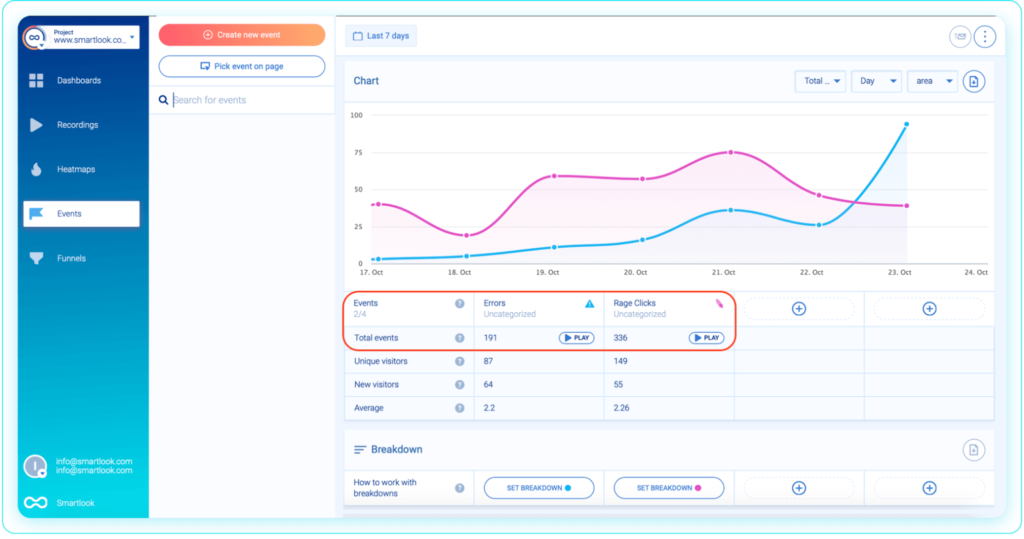
In fact, one of our clients (the biggest search engine for discounts and special offers in Central Europe) found 15 bugs on their website in three hours thanks to Smartlook.
Now, just because you have all your session recordings at your disposal doesn’t mean you have to spend hours watching each one. Quite the opposite — Smartlook comes with 30+ filters that ensure you can always find the precise session you need, when you need it.
For example, you can use location-based filters like city and country or technology filters like device and operating system.

You can even filter session recordings based on user actions (events) that took place in them or by stages in a conversion funnel. We’ll show you how to do that in a bit, but if you’re interested, feel free to skip to that section.
Additionally, our platform has an Identify API, which can be set up on websites and mobile apps that collect user identification details like username or email. When the API is implemented, users’ identifiers (e.g., their email or username) can be used to filter their session recordings.
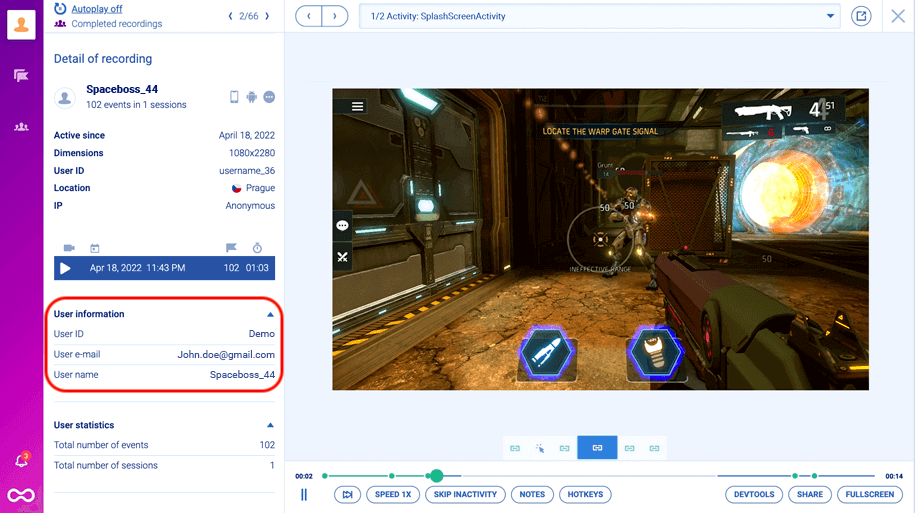
With this functionality, you can get a detailed understanding of the behavior of specific users (e.g., high-paying customers).
You can also resolve bugs reported by users without having to rely on their explanations (which are often inaccurate). For example, when an identified user reports a bug, you can find their session recordings instantly and see what led to the problem.
Retroactive event tracking and funnel analysis without coding
Event tracking is the ability to monitor specific user actions, like button clicks or text inputs, over time. And while most analytics tools can track events, the majority of them require a manual tracking setup before they start collecting user interaction data.
This means you need to carefully plan, implement, and test your tracking instrumentation, and then wait for enough interaction data to accumulate. All of this back and forth often takes weeks or even months.
Conversely, Smartlook captures all user interactions on your site or app automatically and lets you track events without coding.
As you can see in the image below, Smartlook displays a timeline of all user actions right below each session replay.

Because this interaction data is collected automatically, all you need to do is select which of these actions you want to track as events, which you can do without coding by selecting from a drop-down menu of event types or by using our no-code event picker (shown in the screenshot below.)
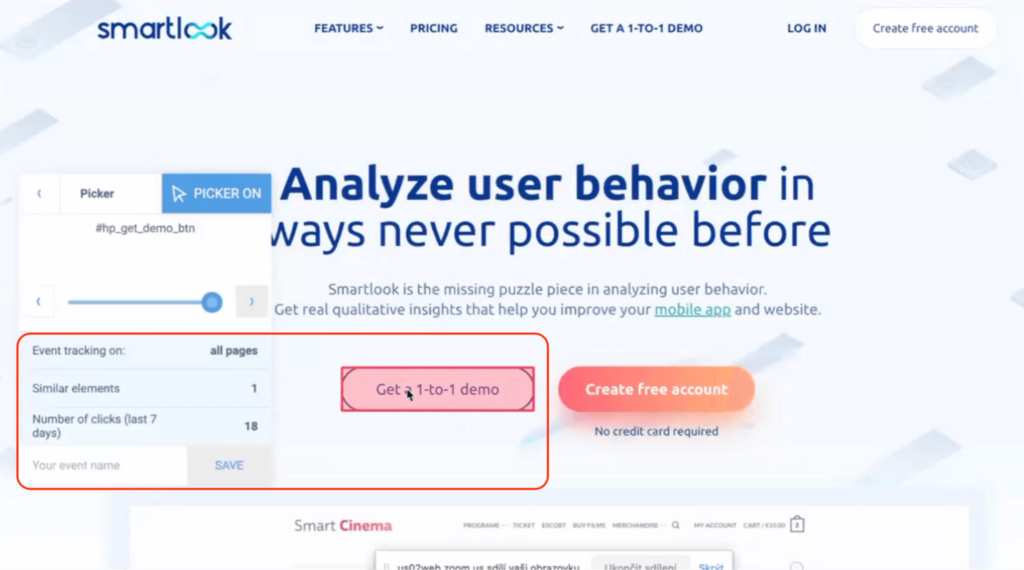
When you define an event, Smartlook identifies every instance of that event, going back as far as your data retention plan goes.
This allows the event tracking visualization to appear instantly, so you can analyze it retroactively, without waiting for data collection.

Put simply, automatic data capture and the ability to define events without coding allow you to:
- Avoid the most difficult parts of tracking events — planning and implementation.
- Start analyzing events immediately after defining them, instead of waiting for new data collection.
Outside of the standard events, you can also create custom ones with JavaScript to track pretty much everything else.
Once the events for your site or app are defined, you can perform quantitative analytics to answer questions like “Which link in our navigation do users click the most?” or “How many times was the CTA on our landing page clicked during our marketing campaign?”
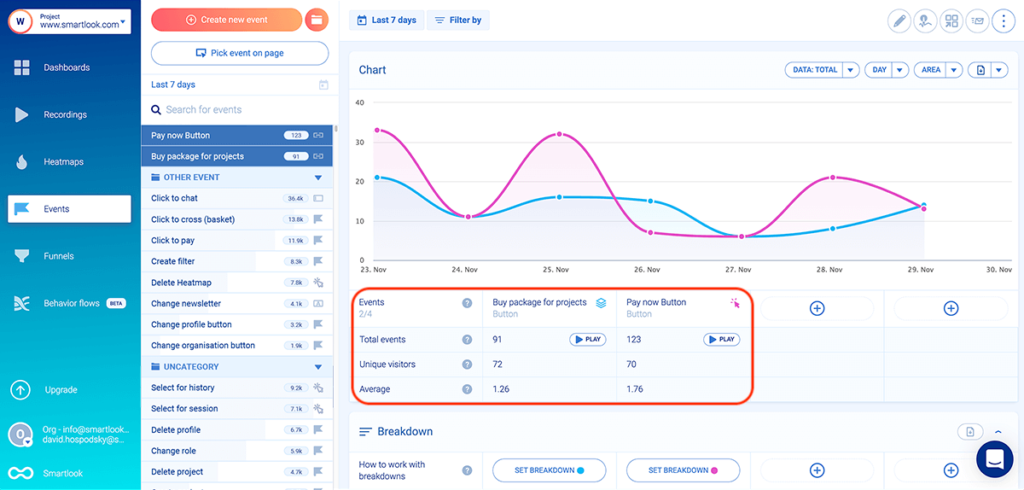
Besides that, you can also use events to build and analyze funnels.
Funnels are sequences of steps (events) users go through to complete a goal, like:
- Buying a product
- Signing up for a newsletter
- Finishing an onboarding tutorial
Smartlook’s funnel analysis feature helps you analyze the customer journey through these flows, as well as calculate the conversion rates and drop-offs between each step.

To create a new funnel, all you have to do is place two or more events in the order you believe your users follow. For example, the screenshot above shows a 3-step checkout funnel built entirely without coding:
- Event 1: A visitor clicks on the “Buy package” button (select the button with our no-code event picker to define the event).
- Event 2: A visitor clicks on the “Pay now” button (again, select the button with our no-code event picker).
- Event 3: The visitor arrives on the “Thank you” page (use the “Visited URL” standard event and enter the page URL).
And again, the interaction data is already collected, so the funnel visualization will appear instantly, like in the GIF below.
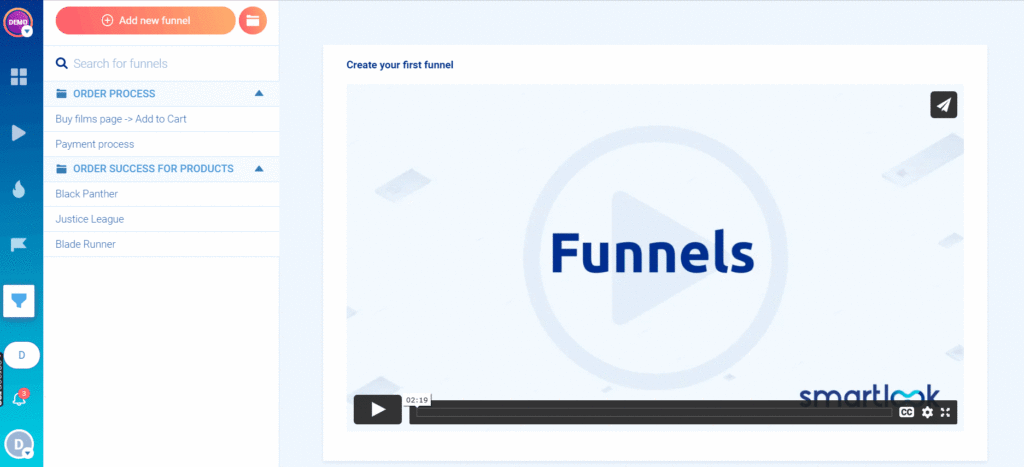
You can try Smartlook’s event tracking and funnel analysis with our live public demo (no registration or credit card required).
Combining quantitative analytics with qualitative data for fast UX insights
By themselves, events and funnels are great for understanding what your users do. However, with Smartlook, you can also combine events and funnels with session recordings to understand why users do what they do.
Here’s how:
- First, you can filter session recordings based on events that took place in them. Each Smartlook event has a “Play” button under its name. Clicking it takes you to all the sessions where that event took place, so you can find relevant session recordings fast and see the full context behind users’ actions (what they did before and after triggering the event).

- Second, you can also watch session recordings of users who entered a funnel, completed a certain step in the funnel, or dropped off between two steps. As you can see, in the screenshot above, there are “Play” buttons under each step of the funnel, including the drop-offs. Clicking these buttons takes you directly to the relevant session recordings.

The ability to combine funnel analysis with session recordings can quickly surface opportunities for reducing drop-offs and boosting your conversion rates, by allowing you to:
- Watch the sessions of all users who entered this funnel (the 264 visitors in Step 1).
- Watch only the sessions of users at a certain step (e.g., the 195 visitors who clicked on “Pay now”).
- Watch users who dropped off between two specific steps (e.g, the 32 session replays of users who dropped off between Steps 2 and 3 to find out why they didn’t check out successfully).
For a detailed introduction to Smartlook that’s tailored to your business, schedule a demo with our team. Or if you want to give our platform a go yourself, sign up for a full-featured, 30-day trial — no credit card required.
2. FullStory

- Supported platforms: Web and mobile.
- Key features: Session recordings, funnels and conversions, event tracking, heatmaps.
- Pricing: No public pricing or free forever plan. There are two paid plans — Business (with limited features and a 14-day trial) and Enterprise.
FullStory is a Digital Experience Intelligence platform. Like Smartlook, it also captures everything your users do automatically and lets you analyze events and funnels retroactively. This makes FullStory easy to set up and use.
Two downsides to this platform are its non-transparent pricing and steep price tag. Many users report having to manually sample their website traffic because they couldn’t afford to leave the session recorder running constantly, as we discussed in our article on the top 11 FullStory competitors.
3. Hotjar

- Supported platforms: Web only.
- Key features: Session recordings, heatmaps, surveys, and user feedback widgets.
- Pricing: Hotjar Observe — which includes session recordings and heatmaps — has a free plan for recording 35 daily user sessions, with paid plans starting at $32/month. Hotjar Ask — which includes user feedback and surveys — also has a free plan for capturing 20 monthly responses, while paid plans start at $48/month.
Hotjar is a beginner-friendly website behavior analytics tool that’s popular with digital marketing, UX, and product teams. Recently, Hotjar was split into two separate products:
- Observe, which includes session recordings and heatmaps
- Ask, which includes user feedback widgets and surveys.
Both can be used separately or together.
Like Smartlook, Hotjar offers transparent and customizable pricing plans suitable for all kinds of businesses. However, it also has severely limited quantitative analytics capabilities and lacks funnel analysis capabilities, which forces some teams to look for Hotjar alternatives.
4. Crazy Egg

- Supported platforms: Web only.
- Key features: Heatmaps, session recordings, traffic analysis, and error tracking.
- Pricing: No free forever plan, Plans start at $29/month, with a 30-day free trial. All plans are billed annually and there’s no free forever plan.
Crazy Egg is a conversion rate optimization (CRO) and web analytics tool. It has different types of heatmaps, as well as overlay reports, user recordings, and features for tracking ad traffic on your website.
Crazy Egg also has an A/B testing feature, so it can also be considered an A/B testing tool. However, Crazy Egg’s A/B testing isn’t nearly as advanced as VWO’s. If you’re using VWO’s testing and personalization features, Crazy Egg probably won’t cut it as an alternative, which is why we aren’t including it in the next category.
5. Glassbox

- Supported platforms: Web and mobile.
- Key features: Session replay, real-user monitoring (RUM), journey mapping, and session vault.
- Pricing: Available upon request.
Glassbox is a digital analytics solution. Like Smartlook, it also captures user behavior data automatically. Glassbox can be deployed on-premises, in the cloud, or in a hybrid environment, depending on customers’ business requirements.
In 2021, Glassbox acquired Convertize — an A/B testing solution. However, at the time of this writing, A/B testing still isn’t a part of the core platform, so Glassbox remains primarily an analytics tool.
6. Heap

- Supported platforms: Web and mobile.
- Key features: Session replay, segmentation, charts, and customizable dashboards
- Pricing: Free plan is available for one product or website. Pricing for paid plans is available upon request.
Heap is a digital insights platform that offers a few different categories of tools for data analysis, data foundation, and data management. Similar to Smartlook, Heap also collects user interactions automatically. While it started as a quantitative analytics solution, Heap acquired session recording tool Auryc and made session replays a part of the core platform.
7. LogRocket

- Supported platforms: Web and mobile.
- Key features: Session replay, frontend performance monitoring, custom metric tracking, and error tracking.
- Pricing: Free plan is available for recording up to 1000 user sessions/month. Paid plans start at $99/month for 10,000 monthly user sessions.
LogRocket is a unique entry to this list, as it has more features for technical teams, like frontend performance monitoring, which provides performance telemetry for in-depth debugging. Besides that, LogRocket also has quantitative and qualitative product analytics capabilities, like session replay, heatmaps, and custom metric tracking.
8. Contentsquare

- Supported platforms: Web and mobile.
- Key features: Customer journey analysis, heatmaps, session replay, and struggle analysis.
- Pricing: Available upon request.
Contentsquare is a digital experience platform. It supports a wide breadth of quantitative and qualitative features that can be used by marketing, analytics, IT and operations, UX, and product teams. While Contentsquare is an enterprise platform, they acquired Hotjar in 2021 to gain ground in the small- and medium-sized (SMB) segment.
VWO Testing, VWO FullStack, and VWO Personalize alternatives for experimentation and personalization
The tools in this category can help you increase conversions via experimentation and personalization. In terms of competing with VWO, most of the tools below come with the following features:
- A/B, multivariate, and split URL testing (VWO Testing)
- Client- and server-side experimentation (VWO FullStack)
- User segmentation, based on different criteria (VWO FullStack)
- Personalization capabilities for providing users with tailored experiences (VWO Personalize).
Note: A/B tests can easily lead you to incorrect conclusions if you don’t run clean experiments. That’s why it’s crucial to verify the accuracy of your tests by watching how users interact with each variant you’re testing. We’ve made it possible to use Smartlook’s session recordings to watch how users interact with your test variants. Learn how to do this (and why you should) in our article on the 10 best A/B testing tools.
9. Optimizely

- Supported platforms: Web and mobile.
- Key features: A/B testing, multi-page experiments, marketing planning, and a content management system (CMS).
- Pricing: There’s a free plan with the most basic functionalities. Paid plans are custom, depending on which Optimizely products you want to use.
Optimizely is a digital experience platform. It has a few different products for:
- Running server-side feature experiments
- Running A/B tests and multi-page experiments
- Creating and scaling content on an enterprise CMS
- Managing marketing tasks, campaigns and content, and more.
Optimizely also has integrations with CRMs (like Salesforce and HubSpot), marketing automation software (like Hootsuite and Marketo), social media apps (like Facebook and LinkedIn), and many other tools, allowing you to incorporate it into your workflow.
Note: See how to integrate Optimizely with Smartlook in this article.
10. Google Optimize (& Firebase A/B Testing)

- Supported platforms: Web (Google Optimize) and mobile (Firebase A/B Testing).
- Key features: A/B testing, multivariate testing, split URL testing, and server-side experiments.
- Pricing: Google Optimize and Firebase A/B Testing are both free.
Google Optimize is an A/B testing software for running different types of tests and creating personalized experiences on websites. It’s also free, which makes it a popular choice for small businesses. Additionally, Google Optimize is designed to work with other Google products like Google Analytics, Google Ads, and Firebase.
Firebase A/B Testing is also a free experimentation tool by Google that’s designed for mobile apps. Firebase A/B Testing is actually powered by Google Optimize, so we’re listing both tools together.
Note: See how to integrate Google Optimize with Smartlook in this article. For our Firebase A/B Testing integration, check out this article.
11. Kameleoon

- Supported platforms: Web and mobile.
- Key features: A/B testing, real-time personalization, and feature management.
- Pricing: Available upon request.
Kameleoon is an A/B testing and personalization platform. Similar to VWO, Kameleoon also bundles its features in different modules:
- A/B Testing for running unlimited A/B and multivariate test variations.
- Full Stack for feature rollouts, updates, and rollbacks.
- Personalization for providing visitors with tailored experiences across channels and devices.
12. Unbounce

- Supported platforms: Web only.
- Key features: Landing page builder, A/B testing, pop-ups, and an AI copywriting generator.
- Pricing: Starts at $90/month with a free 14-day trial.
Unbounce is a platform that combines various products for marketing teams. One of their most popular products is a landing page builder, which lets you create landing pages, customize them without coding, and run A/B tests to see which variants perform better. There’s also a Smart Traffic product that automatically sends visitors to the landing page variant most likely to convert them.
13. A/B Tasty

- Supported platforms: Web and mobile.
- Key features: Client-side experiments, AI-powered personalization, and engagement widgets.
- Pricing: Available upon request.
AB Tasty is a customer experience optimization platform. It combines a few different products under the hood, including:
- Client-Side Experiments for A/B and multivariate testing with a no-code approach.
- Full-Stack Experiments for server-side A/B testing.
- Personalization for segmenting users and creating personalized experiences for them and more.
14. Adobe Target

- Supported platforms: Web and mobile.
- Key features: A/B and multivariate testing, AI-powered automations, and omnichannel personalization.
- Pricing: Available upon request.
Adobe Target is an experimentation platform that’s built for enterprises. It’s part of Adobe Experience Cloud, but it can be used as a standalone product to run A/B and multivariate tests, as well as set up AI-powered automations.
Record every user session on your site or app automatically with Smartlook
Smartlook gives you robust analytics that show what your users are doing — paired with session recordings and heatmaps that show why — all in one place.
Our platform automatically records all user sessions and interactions (no sampling), so you get crucial behavior data with minimal to no intervention from your team.
You can use Smartlook on both:
- Websites, including ones built with popular CMSs like WordPress, Joomla, and Shopify.
- Mobile apps, as Smartlook has SDKs for 10 native mobile app platforms, frameworks, and engines — including iOS, Android, React Native, Flutter, Unity, and Unreal Engine
Smartlook is easy to set up and only takes a few minutes to start collecting user recordings from your website. You can try it out with our full-featured, 30-day trial (no credit card required).
But if you don’t have time to set it up, or you want to see it in action on a mobile platform, you can book a free demo using this form and our team will give you a detailed Smartlook presentation that’s tailored to your business at a convenient time for you.











